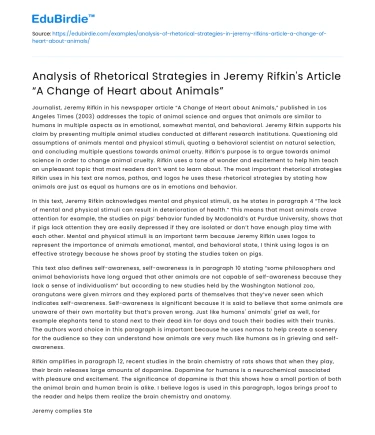Journalist, Jeremy Rifkin in his newspaper article “A Change of Heart about Animals,” published in Los Angeles Times (2003) addresses the topic of animal science and argues that animals are similar to humans in multiple aspects as in emotional, somewhat mental, and behavioral. Jeremy Rifkin supports his claim by presenting multiple animal studies conducted at different research institutions. Questioning old assumptions of animals mental and physical stimuli, quoting a behavioral scientist on natural selection, and concluding multiple questions towards animal cruelty. Rifkin’s purpose is to argue towards animal science in order to change animal cruelty. Rifkin uses a tone of wonder and excitement to help him teach an unpleasant topic that most readers don’t want to learn about. The most important rhetorical strategies Rifkin uses in his text are nomos, pathos, and logos he uses these rhetorical strategies by stating how animals are just as equal as humans are as in emotions and behavior.
In this text, Jeremy Rifkin acknowledges mental and physical stimuli, as he states in paragraph 4 “The lack of mental and physical stimuli can result in deterioration of health.” This means that most animals crave attention for example, the studies on pigs’ behavior funded by Mcdonald’s at Purdue University, shows that if pigs lack attention they are easily depressed if they are isolated or don’t have enough play time with each other. Mental and physical stimuli is an important term because Jeremy Rifkin uses logos to represent the importance of animals emotional, mental, and behavioral state, I think using logos is an effective strategy because he shows proof by stating the studies taken on pigs.
Save your time!
We can take care of your essay
- Proper editing and formatting
- Free revision, title page, and bibliography
- Flexible prices and money-back guarantee
This text also defines self-awareness, self-awareness is in paragraph 10 stating “some philosophers and animal behaviorists have long argued that other animals are not capable of self-awareness because they lack a sense of individualism” but according to new studies held by the Washington National zoo, orangutans were given mirrors and they explored parts of themselves that they’ve never seen which indicates self-awareness. Self-awareness is significant because it is said to believe that some animals are unaware of their own mortality but that’s proven wrong. Just like humans' animals' grief as well, for example elephants tend to stand next to their dead kin for days and touch their bodies with their trunks. The authors word choice in this paragraph is important because he uses nomos to help create a scenery for the audience so they can understand how animals are very much like humans as in grieving and self-awareness.
Rifkin amplifies in paragraph 12, recent studies in the brain chemistry of rats shows that when they play, their brain releases large amounts of dopamine. Dopamine for humans is a neurochemical associated with pleasure and excitement. The significance of dopamine is that this shows how a small portion of both the animal brain and human brain is alike. I believe logos is used in this paragraph, logos brings proof to the reader and helps them realize the brain chemistry and anatomy.
Jeremy complies Stephen M. Sivity, a behavioral scientist at Gettysburg college in Pennsylvania who asks a question “if you believe in evolution by natural selection, how can you believe that feelings suddenly appeared, out of the blue, with human beings? Until recently scientists believed that learned behavior was wired activity. We know that geese teach their gosling their migration routes. This is significant because pathos is used here, pathos is used by Jeremy using Stephen’s question, which helps put the audience into a certain frame of mind. I believe using pathos is important because it helps put the mind into a perspective as in thinking about how humans suddenly appeared with feelings. Nomos is also used here because there are multiple values and belfies used, as in it is believed that learned behavior is wired activity handed down by our parents.
All of the evidence provided by Jeremy Rifkin implied in this context, are good ideas because he helps the audience understand that animals have rights just like humans do, how alike we all are. He uses multiple examples indicating that animals should have animal rights and that cruelty towards animals should stop. Our behavior, mental and emotional state is all somewhat the same. This article is based on all of those aspects. I think this article is very effective because of all of his rhetorical strategies used as in logos, pathos, and nomos all of this helps the audience learn about a tough subject that they wouldn’t want to learn in the first place.






 Stuck on your essay?
Stuck on your essay?

